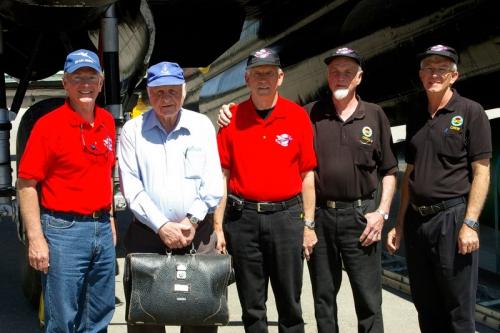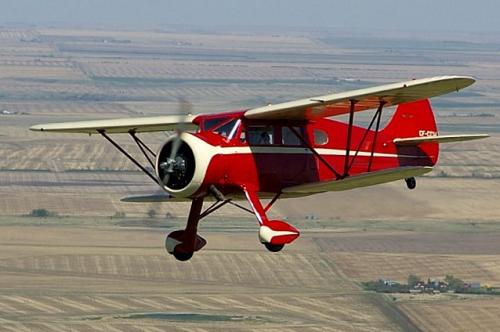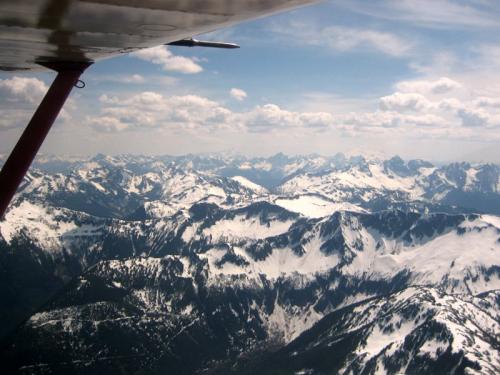Back to Baddeck – CAPA style
Under the leadership of the Canadian Aeronautical Preservation Association (CAPA), aviation museums and aviation heritage sites across Canada celebrated the 100th anniversary of powered flight in Canada with a unique and historically oriented event - a coast-to-coast-to-coast flying relay to mark this very significant aviation milestone. This Canada relay stopped at all of the CAPA member museums across Canada, at each provincial/territorial capital as well as in the nation’s capital, Ottawa, and was completed using a variety of vintage aircraft.
The Canadian Museum of Flight (CMF), BC’s only flying aviation museum, played a major role in this relay. The Museum’s Harvard flew from Comox to Victoria and the Tiger Moth, from Victoria to Langley. This story unfolds as the CMF’s 1937 Waco and crew took their turn at being a part of history and continuing the relay, with the mail bag in hand, to Nanton, AB.
For the Waco crew (Bill Findlay, Dave Beales and Doug Moan) – the big day finally arrived! May 27, 2009, was planned as day one of “Bill’s, Dave’s and Doug’s Excellent Aviation Adventure.” The CMF’s big red and white 1937 Waco Cabin (CF-CCW) gleamed in the sunshine and seemed as eager as the three crew members to get the show on the road. Many hours had been spent on the Waco during the winter months in order that this beautiful aircraft continue its airworthy status and be ready for the flight. An overhaul of the brake system was a major improvement in the ground handling of the aircraft. The maintenance crew had done a great job of preparing the Waco for what was to be the longest flight legs and the farthest from home that she had flown in many years.

L. to R. at Langley. Crew members for the flight: Doug Moan - maintenance, Vic Bentley - Harvard, and Dave Beales and Bill Findlay - Waco pilots.
A good crowd of family, friends and supporters was on hand at the Langley based Museum to wish the crew all the best on their journey to points east. The ever-faithful Jacobs 330 HP radial engine roared to life and we taxied away from the crowd to prepare for our maximum weight takeoff from runway 19 at Langley. Partly cloudy skies let the sun shine through to beckon the flight onward and upward toward the Coast Mountains of southern BC. A great sense of excitement filled the Waco’s cabin as we sped down the runway and slowly climbed away from the airport. Bill kept the aircraft close to the airport initially in order to return for the traditional departure flyby to bid farewell to the onlookers below. Dirty work, but somebody has to do it!
The Museum’s Tiger Moth (George Serviss) and SE5a (Gil Fanslau) had departed Langley a short while before the Waco and were positioned near Mission to provide escort as we headed east towards Chilliwack and Hope. A Globe Swift (John Northey) was also on hand to come along side for a final flight inspection. Vic Bentley, and his beautiful Harvard 4, was also there. Vic was very happy to provide escort for the Waco crew for most of the journey to Alberta and back.
The Waco aircraft performed flawlessly as we crossed the majestic Coast Mountains and followed Highway 3 to our first stopover – Penticton. We circled Bill’s parent’s home in Kaleden as a signal that we had arrived in the Okanagan. They showed up at the airport shortly after with a vehicle that the crew could use for their overnight stop at Bill’s cabin on the shore of Skaha Lake. Doug’s “low level refreshment light” was on by this time and the barbeque meal and refreshments were eagerly consumed as plans were made for day two’s flight operation.
May 28th was another sunny day as the crew made their way to the airport. Before takeoff, a local newspaper reporter completed an interview which made the front page of the Penticton Herald. Today’s flight would take us to Nelson for lunch. Our routing through the southern Okanagan and then east to Grand Forks, Christina Lake, Castlegar and Nelson, afforded the crew a fantastic view of this very unique area of Canada. Nelson airport is nestled amongst the Selkirk Mountains in a very narrow valley on the shore of the west arm of Kootenay Lake – a most interesting location. After parking on the main ramp, we were given a ride by airport personnel to the centre of town where we enjoyed an outdoor lunch at one of the many good restaurants in Nelson. Upon arrival back at the airport, we flight planned, fueled the aircraft and prepared for departure.

The view from the west approaching Nelson - a jewel nestled amongst the Selkirk Mountains.
Leg two of today’s flight plan had us departing Nelson (with a flyby, of course) and heading east to Balfour and then down Kootenay Lake to Creston Valley airport. What a picturesque valley this is with its extensive system of engineered dikes to allow year round use of this fertile land for farming. After securing the aircraft for the day, we spent some time touring the hangar of Bill Piper and being shown his pride and joy, a rare and immaculately restored 1929 Monocoach, the only flight worthy example in the world. Local friends of Vic were kind enough to provide transportation to accommodation in town where we freshened up and met for dinner. Day two had been another memorable day of flying through southern BC.

Bill Piper and his rare and beautiful 1929 Monocoach at Creston airport.
Friday, May 29th, presented yet another glorious day. A newspaper reporter was on hand for an interview which once again made the front page. Today’s plans included packing a lunch for the stopover at Sparwood airport where there is fuel but no dining facility. This was another very interesting flight from Creston, eastward to Sparwood via Yahk, Cranbrook and Fernie. The air was as clear as we had ever seen and the opportunities for photography were limitless – snow-capped mountains and deep lush valleys at every turn. Our picnic lunch was enjoyed on the banks of the rushing Elk River – a short walk across the airport and through a meadow. The huge Elkview coal mining operations and associated equipment were visible in the distance.

The Waco and Harvard on the ramp at Sparwood's Elk Valley Airport.
After checking out Sparwood airport and fueling the aircraft, we departed on the flight through the Crow’s Nest Pass, by the Frank Slide and on into southern Alberta. This was another amazing flight through the Rockies, the foothills and then over the flat lands south of Nanton, AB. Nearing Nanton, we set up to fly two formation passes (Waco and Harvard) over downtown and the Nanton Lancaster Society Air Museum location. From there it was a short flight north for a landing at the AJ Flying Ranch where we were met by several members of the Nanton Museum. The aircraft were fueled and put in the large hanger at this airfield. Thanks to Alex Bahlsen for having us as guests at his fabulous airport facility with its 4500 x 50 foot asphalt runway.
To say that we were treated royally by the Nanton people would be an understatement. Transportation, food and lodging were provided by these wonderful aviation enthusiasts and we spent the evening exchanging flying and museum stories with our hosts.
Saturday, May 30th, was mailbag handover day. But before this ceremony commenced, we toured the excellent Nanton Museum and enjoyed the sight and sounds of the Merlin engine starts on the Lancaster. We also attended a briefing by Museum member Karl Kjarsgaard on plans to locate and raise a Halifax aircraft from the ocean floor off the coast of Ireland. This Halifax had been operated by Canadian crews and it is hoped that it will eventually be on display alongside the Lancaster in Nanton. What a sight that will be!

The Waco crew 'passing the baton' (mailbag) - l. to r. - Bill Findlay, Gordon Jones (Tiger Moth), Dave Beales, Doug Moan and Vic Bentley.
Just before noon, we all gathered in front of a large crowd to proceed with the mailbag handover ceremony. Tiger Moth pilot, Gordon Jones, accepted the “baton” which would later be transported by the Moth crew and other aircraft to several destinations in Alberta. Following the ceremony, we said our goodbyes and were whisked off to the AJ Flying Ranch to prepare the aircraft for the flight to Wetaskiwin. But before heading north, we flew back to Nanton for more formation flying to say goodbye to the townspeople who were enjoying the annual Planes, Trains and Elevators event. We are truly indebted to the Nanton Museum staff and volunteers for the kindness and goodwill extended to us during our stay in Nanton.
The flight to Wetaskiwin was uneventful and we arrived in time to freshen up and return to the airport for the Canadian Aviation Hall of Fame’s Induction Dinner at the Reynolds-Alberta Museum. Our main reason for attending was to support BC’s own Barry Marsden (Conair) who was one of the inductees that evening. The event was very interesting and we had an opportunity to talk with Barry to congratulate him on this prestigious award. Bill also spent a few minutes chatting with his former Wardair boss, Max Ward, who was presenting the awards that evening.
The next day, Sunday, was spent touring the very extensive museum facility at Wetaskiwin airport. The collection of aircraft, autos and farm machinery is most impressive and very well displayed. The storage buildings contain many more artifacts awaiting restoration, some of them in fine enough condition to be used as museum displays now. Vic and his Harvard departed for Golden this afternoon for a visit with family and then on to Langley the following day.

The CMF's 1937 Waco over the flatlands to the south of Nanton, AB.
Day six was the start of the long journey back to Langley for the Waco crew. After checking the weather, filing a flight plan and packing a lunch, we launched from Wetaskiwin into the wild blue yonder on the next flight leg to Sparwood, BC. The Waco was refueled in Sparwood, we enjoyed another picnic lunch (this time on the clubhouse veranda) and then we departed for our last overnight stop – back once more to Creston. As luck would have it, the tail winds found on the flights to the east had now switched around to provide us with tailwinds and good groundspeeds that would last all the way to Langley. During the Creston layover, we were treated by Bill Piper to a very informative tour of the valley that included an explanation of the system of dikes that his family had helped build in the early days of farming there. Dinner and crew rest were next on the program.
We awoke to yet another sunny day which allowed for easy flight planning on this the final day of our journey. From Creston, we climbed the big red Waco up to altitude and followed the Creston/Salmo highway to Trail and then via Grand Forks to our next fuel stop at Oliver in the southern Okanagan. Bill’s parents, Ray and Win, met us there for lunch and then it was off to Langley for the last leg of this outstanding adventure. This final leg routed via Keremeos, Princeton, Manning Park, Hope, and Chilliwack to an on time arrival at Langley. We were continually dazzled by the incredible scenery that BC has to offer, especially as seen from the air. We all agreed that Doug had the best seat in the house as he roamed from side to side in the spacious comfort of the Waco’s rear seat.

Almost home - flight above the Coast Mountains southeast of Hope, BC.
Our excellent adventure had been one hundred years in the making. Did we have a good time? Yes, we certainly did! Did the Waco perform up to its potential? It met and even exceeded our expectations. What a wonderful flying machine is this 1937 Waco Cabin. Thanks to all who had a part in making this journey possible. We are all so fortunate to be members of a Museum whose policy it is to maintain several aircraft in flying condition so that these classic machines can be seen and heard in their natural environment – flight!
For more information on CAPA and this back to Baddeck relay, please refer to the following web link: http://www.capa-acca.com/back_to_baddeck_toc.htm and enjoy a trip down memory lane.